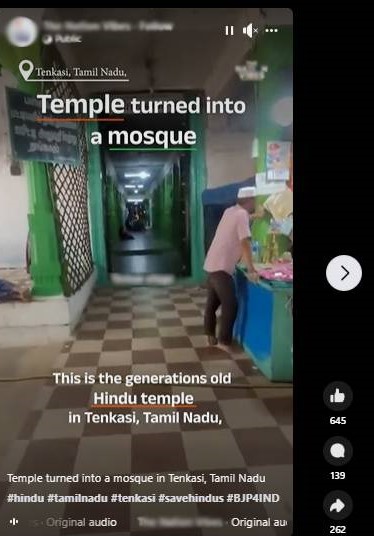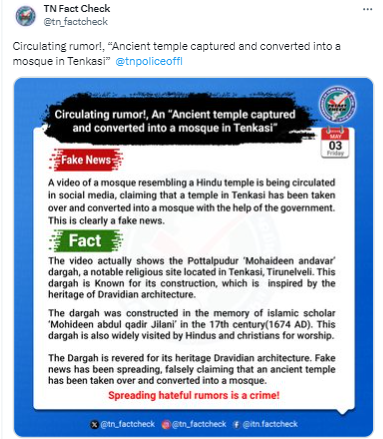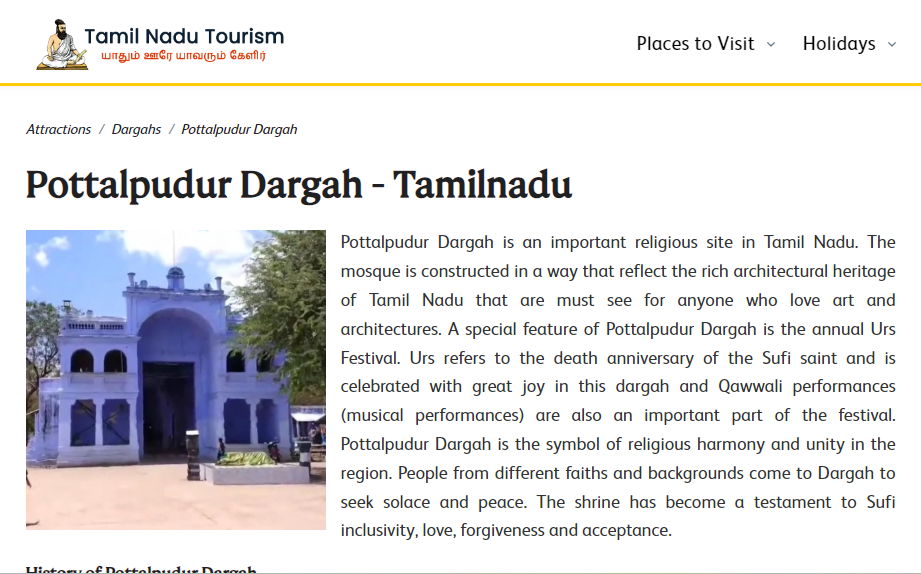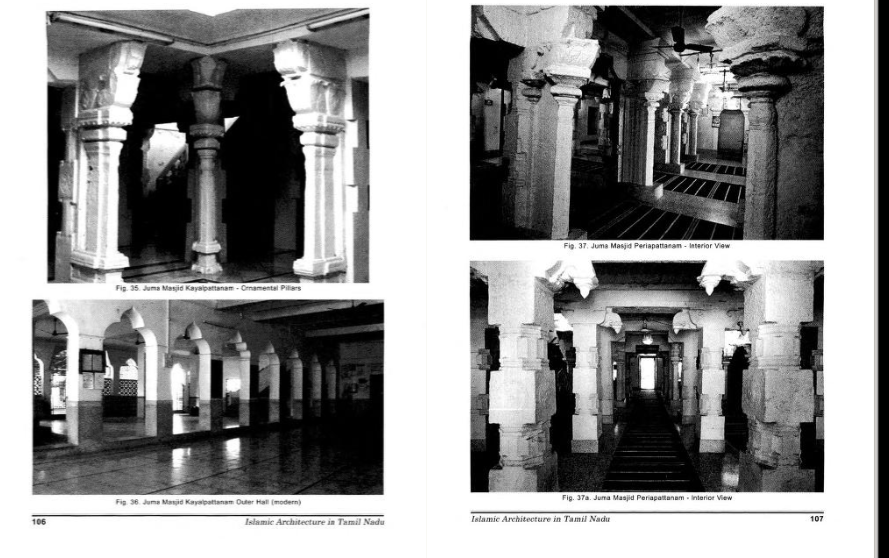A video is being widely shared on social media claiming it as the visuals of an ancient temple that is converted into a Mosque in Tenkasi, Tamil Nadu (here, here, here, & here). Let’s verify the claim made in the post.

The archived version of this post can be found here.
Claim: Video of an ancient temple that is now converted into a Mosque in Tenkasi, Tamil Nadu.
Fact: The video depicts Pottalpudur Dargah, situated in Tenkasi, Tirunelveli district of Tamil Nadu. There is no evidence to suggest that the mosque was previously a temple. According to information available on the Tamil Nadu tourism website, the dargah was constructed in the memory of Islamic scholar Mohideen Abdul Qadir Jilani in the 17th century (1674 AD) and is renowned for its construction inspired by the heritage of Dravidian architecture. In Tamil Nadu, many mosques are built using Dravidian architecture, with Jumma Palli (Keezhakarai Mosque) in Kilakarai being one of the most notable examples. The Tamil Nadu government fact-checking organization also refuted the viral claim. Hence, the claim made in the post is FALSE.
To verify the accuracy of the viral claim, we conducted a relevant keyword search. This search led us to a post on (archive link) on the official Tamil Nadu government’s fact-check X handle. According to this post, “the viral claim is false, and the video actually depicts Pottalpudur Mohaideen Andavar Dargah, located in Tenkasi, Tirunelveli. This dargah was constructed in the memory of Islamic scholar Mohideen Abdul Qadir Jilani in the 17th century (1674 AD) and is renowned for its construction inspired by the heritage of Dravidian architecture. Moreover, this dargah is widely visited by Hindus and Christians for worship.“

According to information available on the Tamil Nadu state tourism website, Pottalpudur Dargah is an important religious site in Tamil Nadu. The mosque is constructed in a way that reflects the rich architectural heritage of Tamil Nadu, making it a must-see for anyone who loves art and architecture. It is believed that Sufi saints, during their travels from Iran to India, reached Pottalpudur village and decided to settle there, preaching Islam to the people. Later, after the death of the head Sufi saint, people erected a tomb for the head Sufi saint in the year 1674, which has been worshipped in the mosque ever since. A special feature of Pottalpudur Dargah is its beautiful architecture. The main entrance of the dargah is adorned with intricate carvings and beautiful calligraphy, showcasing the artistic skills of the artisans of that time. This dargah was not only built by Muslims but also by Hindus and Christians. The inner sanctum of the dargah houses the tomb, covered by an elaborate silver canopy. Devotees who visit this dargah are given holy ashes made from ghee, tamarind bark, and flowers, known as ‘Nerchai’.

In the Madras High Court’s case related to the management of the Pottalpudur Dargah trust, it is stated that the dargah, built in 1674, is the oldest one, and not only Muslims but also Hindu and Christian devotees visit it.

In Tamil Nadu, there are many mosques built using Dravidian architecture. The book “Islamic Architecture in Tamil Nadu,” written by Dr. Raja Mohammed and published by the Director of Museums, Government Museum Chennai, discusses various mosques and dargahs constructed in the Dravidian style, resembling temples. Among them, Jumma Palli (Keezhakarai Mosque) in Kilakarai stands out as the most notable example. Additionally, there are other mosques in different states of India that bear resemblance to temples. Some examples can be seen here, here and here.

Previously, Factly debunked similar claims regarding both the Jumma Palli mosque in Tamil Nadu and the Zeenath Baksh Mosque in Mangalore, Karnataka, which can be seen here and here.
To sum up, the Pottalpudur Dargah in Tenkasi, Tamil Nadu, was not originally a Hindu temple.



